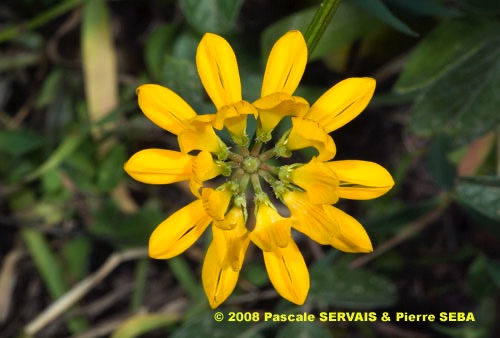
Securigera securidaca (L.) Degen & Dörfl.
Fam. : Fabaceae
Plante herbacée, hermaphrodite, à tiges étalées à ascendantes, creuses, glabres ou à poils rares.
Feuilles alternes, composées imparipennées, à 9 à 15 folioles oblongues, parfois échancrées, à sommet tronqué avec une petite pointe. Petites stipules ovales, aiguës, libres entre elles.
Fleurs à symétrie bilatérale, jaunes, veinées de pourpre, de 6 à 12 mm de long, réunies en bouquets en couronne de 3 à 5 cm de diamètre, portés par un pédoncule plus long que la feuille sous-jacente. Corolle papilionacée, carène munie d’un bec. Calice à 5 dents, dont 2 plus longuement soudées entre elles. Ovaire supère.
Fruits, gousses courbées, de 5 à 10 cm de long, linéaires, ascendantes à dressées, à bords épais, à long bec terminal.
___________________________
Plant herbaceous, hermaphrodite. Stems spread out to ascending, hollow, glabrous or with rare hairs.
Leaves alternate, compound imparipinnate, with 9 to 15 oblong leaflets, sometimes indented, with a truncate top with a small point. Stipules small, ovate, acute, free between them.
Flowers bilaterally symmetrical, yellow with purple veins, from 6 to 12 mm long, joined together in crown-shaped clusters from 3 to 5 cm in diameter, carried by a peduncle longer than the underlying leaf. Corolla papilionaceous, keel provided with a beak. Calyx with 5 teeth, including 2 more lengthily fused with each other. Ovary superior.
Fruits, curved pods, from 5 to 10 cm long, linear, ascending to erect, with thick edges and with a long terminal beak.
1
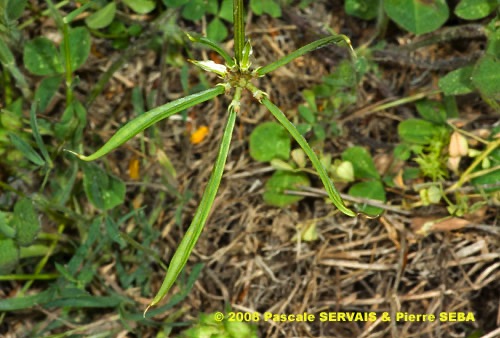
2
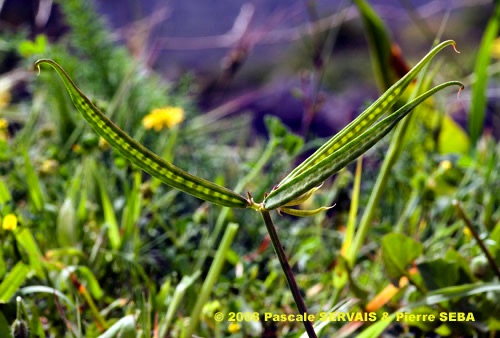
3
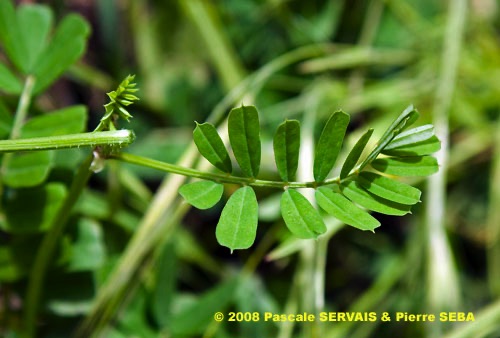
4
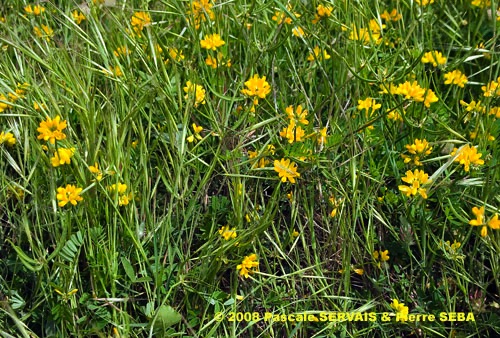
5
Étymologie / Etymology :
Securigera : emprunt du latin securiger, -era, -erum (adj.)
[ < securis, -is (nom) = la hache, le sabre + gero, -is, -ere (verbe)
= porter ] = qui porte une hache, en référence aux gousses en forme
de sabre.
Securidaca : emprunt du latin securidaca, -ae (nom)
[ < securis, -is (nom) = la hache, le sabre + daca, -ae (?) (nom)
= la dague, le poignard ] = la coronille, nom donné à la plante par
Pline, naturaliste latin mort en 79 apr. J.-C., en référence aux gousses
en forme de poignard.
Securigera : borrowed from Latin securiger, -era, -erum (adj)
[ < securis, -is (noun) = axe, sword + gero, -is, -ere (verb)
= to bear ] = axe-bearing, referring to the sword-shaped pods.
Securidaca : borrowed from Latin securidaca, -ae (noun)
[ < securis, -is (noun) = axe, sword + daca, -ae (?) (noun)
= scraping-knife, dagger ] = hatchet vetch, name given to the plant by
Plinius, Latin naturalist died in 79 AD, referring to the dagger-shaped
pods.
Synonymes / Synonyms :
Coronilla securidaca L.
Securigera coronilla DC.
Bonaveria securidaca (L.) Halácsy
Bonaveria securigera Endl. ex Heynh.
Coronilla securigera Salisb.
Securidaca legitima Gaertn.
Securidaca lutea Mill.
Securigera hispidula Gand.
Securigera mediterranea Gand.
Securilla securidaca (L.) Steud.
Securina lutea Medik.
Noms vernaculaires / Common names :
Noms français / French names :
Sécurigéra — Sécurigère en forme de hachette.
Noms anglais / English names :
Goat pea — Hatchet vetch — Scorpion vetch.
Noms allemands / German names :
Schwertförmige Kronwicke — Ziegen-Kronwicke.
Nom italien / Italian name :
Securidaca.
Habitat :
Cultures - Lieux incultes - Lieux humides, mares.
Cultivated places - Waste ground - Damp places, ponds.
Île / Island :
Tilos.
Hauteur / Height range :
De 10 cm à 50 cm.
From 10 cm to 50 cm.
Floraison / Flowering time :
De mars à juin.
From March to June.
Groupe / Classification :
Dicotylédones.
Dicotyledons.
Pérennité / Lifespan :
Annuelle.
Annual.
Description :
© Pascale SERVAIS & Pierre SEBA, 2018. Tilo Botanica: Flore de Tilos et du Dodécanèse / Flora of Tilos and of the Dodecanese
English translation by Brenda Bradbury, Howard Bradbury and Stéphane Léonard
Descripteurs / Identifying features
Photo 1 :
Localisation / Location : Tilos, Megalochorio, Aghios Andonis
Date : 14/04/2008
GPS : Lat. 36,45798° N / Long. 27,33270° E / Alt. 3 m
Type : Photographie numérique / Digital Photograph (10 mégapixels)
Photo 2 :
Localisation / Location : Tilos, Megalochorio, Aghios Andonis
Date : 14/04/2008
GPS : Lat. 36,45798° N / Long. 27,33270° E / Alt. 3 m
Type : Photographie numérique / Digital Photograph (10 mégapixels)
Photo 3 :
Localisation / Location : Tilos, Megalochorio, Aghios Andonis
Date : 14/04/2008
GPS : Lat. 36,45798° N / Long. 27,33270° E / Alt. 3 m
Type : Photographie numérique / Digital Photograph (10 mégapixels)
Photo 4 :
Localisation / Location : Tilos, Megalochorio, Aghios Andonis
Date : 14/04/2008
GPS : Lat. 36,45798° N / Long. 27,33270° E / Alt. 3 m
Type : Photographie numérique / Digital Photograph (10 mégapixels)
Photo 5 :
Localisation / Location : Tilos, Megalochorio, Aghios Andonis
Date : 14/04/2008
GPS : Lat. 36,45798° N / Long. 27,33270° E / Alt. 3 m
Type : Photographie numérique / Digital Photograph (10 mégapixels)

Google Maps
Google Maps
Google Maps
Google Maps
Google Maps